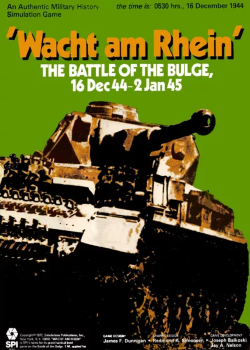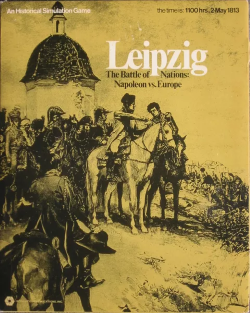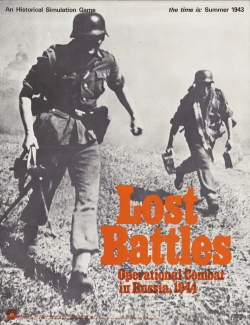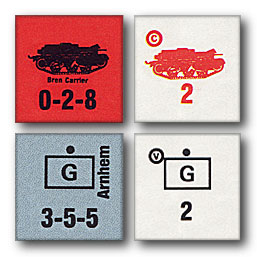
A wargame is a strategy game in which two or more players command opposing armed forces in a simulation of an armed conflict. Wargaming may be played for recreation, to train military officers in the art of strategic thinking, or to study the nature of potential conflicts. Many wargames re-create specific historic battles, and can cover either whole wars, or any campaigns, battles, or lower-level engagements within them. Many simulate land combat, but there are wargames for naval, air combat, and cyber as well as many that combine various domains.

A strategy game or strategic game is a game in which the players' uncoerced, and often autonomous, decision-making skills have a high significance in determining the outcome. Almost all strategy games require internal decision tree-style thinking, and typically very high situational awareness.

Columbia Games is one of the oldest manufacturers of board wargames, and has also produced the Hârn role-playing game as well as various card games and collectible card games. Their wargames are notable for using small wooden or plastic blocks instead of the more conventional cardboard counters. The company, originally titled Gamma Two Games, started in Vancouver, Canada, but after ten years changed its name to Columbia Games, and eventually moved to Blaine, Washington. It is currently run by founder Tom Dalgliesh and his son Grant.

Squad Leader is a tactical level board war game originally published by Avalon Hill in 1977. It was designed by John Hill and simulates on infantry combat in Europe during World War II. One of the most complex war games of its time, Squad Leader is the natural extension of the trend towards greater realism initiated by several earlier games, including Avalon Hill's own PanzerBlitz and Panzer Leader. Those two earlier games were slightly larger in scope, with counters representing platoons and map hexes measuring 250 metres across, compared to Squad Leader's 40 meter hexes and squad sized units.

Greyhawk Wars is a fantasy board wargame that was published by TSR, Inc. in 1991. The game was designed by David Cook as a strategic simulation of the eponymous Greyhawk Wars on the fictional world of Oerth, the World of Greyhawk campaign setting for the Dungeons & Dragons role-playing game.

The Russian Campaign is a strategic board wargame published by Jedko Games in 1974 that simulates combat on the Eastern Front during World War II. Avalon Hill later bought the game and produced several editions.
Real-time tactics (RTT) is a subgenre of tactical wargames played in real-time, simulating the considerations and circumstances of operational warfare and military tactics. It is differentiated from real-time strategy gameplay by the absence of classic resource micromanagement and base or unit building, and by the greater importance of individual units and a focus on complex battlefield tactics.

A block wargame is a board wargame that represents military units using wooden blocks instead of cardboard counters or metal/plastic miniatures.

Kriegsspiel is a genre of wargaming developed by the Prussian Army in the 19th century to teach battlefield tactics to officers. The word Kriegsspiel literally means "wargame" in German, but in the context of the English language it refers specifically to the wargames developed by the Prussian army in the 19th century. Kriegsspiel was the first wargaming system to have been adopted by a military organization as a serious tool for training and research.

Tactics is a board wargame published in 1954 by Avalon Hill as the company's first product. Although primitive by modern standards, it and its sequel, Tactics II, signalled the birth of modern board wargaming for the commercial market. Tactics is generally credited as being the first commercially successful board wargame.

A board wargame is a wargame with a set playing surface or board, as opposed to being played on a computer or in a more free-form playing area as in miniatures games. The modern, commercial wargaming hobby developed in 1954 following the publication and commercial success of Tactics. The board wargaming hobby continues to enjoy a sizeable following, with a number of game publishers and gaming conventions dedicated to the hobby both in the English-speaking world and further afield.

Dixie, subtitled "The Second War Between the States", is a board wargame designed by Redmond A. Simonsen and published by Simulations Publications, Inc. (SPI) in 1976 that simulates an alternate world where the Union lost the first American Civil War, and there is a second war between the North and the South in the early part of the 20th century.

A wargame, generally, is a type of strategy game which realistically simulates warfare. A professional wargame, specifically, is a wargame that is used by military organizations to train officers in tactical and strategic decision-making, to test new tactics and strategies, or to predict trends in future conflicts. This is in contrast to recreational wargames, which are designed for fun and competition.

A wargame is a strategy game that realistically simulates warfare. Wargames were invented for the purpose of training military officers, but they eventually caught on in civilian circles, played recreationally.

Wacht am Rhein is a grand tactical monster board wargame published by Simulations Publications, Inc. (SPI) in 1977 that simulates Germany's Battle of the Bulge offensive in late 1944 during World War II.

Quebec 1759 is a board wargame published in 1972 by Gamma Two Games that simulates the Battle of the Plains of Abraham outside the walls of Quebec in 1759. The game uses wooden blocks set on their edge rather than the more traditional cardboard counters, unique for a wargame in 1972.

Leipzig: The Battle of Nations, subtitled "Napoleon vs. Europe", is a board wargame published by Simulations Publications Inc. (SPI) in 1969 that simulates the 1813 campaign of Napoleon in central Europe, including the Battle of Leipzig. The game was one of the first Napoleonic board wargames, and a number of innovative rules such as the effect of individual leaders on combat were adopted by other wargame publishers.

Lost Battles: Operational Combat in Russia is a board wargame published by Simulations Publications Inc. (SPI) in 1971 that simulates hypothetical combat situations set in the Soviet Union during World War II.

Cambrai, 1917: The First Blitzkrieg is a board wargame published by Rand Game Associates in 1974 that simulates the Battle of Cambrai during the First World War.

EuroFront, subtitled "War in Europe, 1939-45", is a set of board wargame rules published by Columbia Games in 1995 that allows the previously published EastFront, WestFront and MedFront wargames to be combined into one campaign that simulates the entire European Theatre of World War II. In addition to the Allied and Axis counters in these three games, EuroFront also adds pieces representing many other nationalities such as Dutch, Polish and Greek.





















